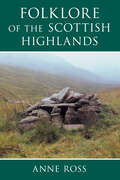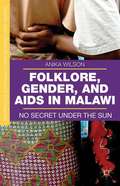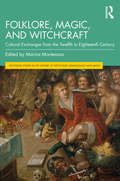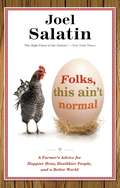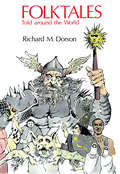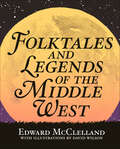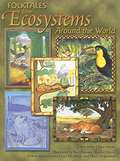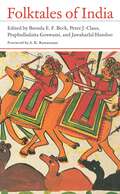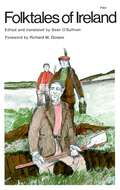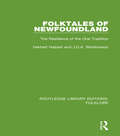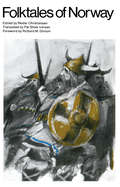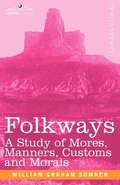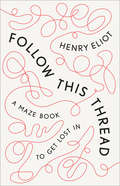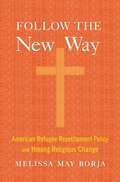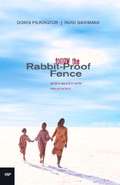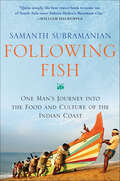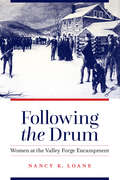- Table View
- List View
Folklore of Yorkshire (Folklore)
by Kai RobertsThe beautiful county of Yorkshire is the largest in England, and yet still possesses a strong and cohesive regional identity. Built on centuries of shared tradition, a characteristic body of folklore has thrived and endured well into the present day.Folklore of Yorkshire chronicles such beliefs throughout the whole county, identifying distinctive common themes, placing them in their historical context and considering their social and psychological function. You’ll discover Yorkshire’s holy wells and buried treasure, its boggarts, Black Dogs and fairies, and the legends behind the county’s stunning landscape.This fully illustrated book shows how the customs of the past have influenced the ways of today, whilst also revealing something about the nature of folklore itself, both for the tradition-bearers and those who collect it.
Folklore of the Scottish Highlands (Folklore)
by Anne RossThe folklore of the Scottish Highlands is unique and very much alive. Dr Anne Ross is a Gaelic-speaking scholar and archaeologist who has lived and worked in crofting communities. This has enabled her to collect information at first hand and to assess the veracity of material already published. In this substantially revised edition of a classic work first published 30 years ago, she portrays the beliefs and customs of Scottish Gaelic society, including: seasonal customs deriving from Celtic festivals; the famous waulking songs; the Highland tradition of seers and second sight; omens and taboos, both good and bad; and, chilling experiences of witchcraft and the Evil Eye Rituals associated with birth and death. Having taken her MA, MA Hons and PhD at the University of Edinburgh, Anne Ross became Research Fellow in the School of Scottish Studies, Edinburgh. She then rapidly established herself as one of Britain's leading Celtic scholars. Her seminal work is "Pagan Celtic Britain" and she has also published "Druids - Preachers of Immortality" with Tempus Publishing.
Folklore, Gender, And Aids In Malawi
by Anika WilsonInformal folk narrative genres such as gossip, advice, rumor, and urban legends provide a unique lens through which to discern popular formations of gender conflict and AIDS beliefs. This is the first book on AIDS and gender in Africa to draw primarily on such narratives. By exploring tales of love medicine, gossip about romantic rivalries, rumors of mysterious new diseases, marital advice, and stories of rape, among others, it provides rich, personally grounded insights into the everyday struggles of people living in an era marked by social upheaval.
Folklore, Magic, and Witchcraft: Cultural Exchanges from the Twelfth to Eighteenth Century (Routledge Studies in the History of Witchcraft, Demonology and Magic)
by Marina MontesanoThis volume offers 18 studies linked together by a common focus on the circulation and reception of motifs and beliefs in the field of folklore, magic, and witchcraft. The chapters traverse a broad spectrum both chronologically and thematically; yet together, their shared focus on cultural exchange and encounters emerges in an important way, revealing a valuable methodology that goes beyond the pure comparativism that has dominated historiography in recent decades. Several of the chapters touch on gender relations and contact between different religious faiths, using case studies to explore the variety of these encounters. Whilst the essays focus geographically on Europe, they prefer to investigate relationships over highlighting singular, local traits. In this way, the collection aims to respond to the challenge set by recent debates in cultural studies, for a global history that prioritises inclusivity, moving beyond biased or learned attachments toward broader and broadening foci and methods. With analysis of sources from manuscripts and archival documents to iconography, and drawing on writings in Latin, Hebrew, Arabic, and other languages, this volume is essential reading for all students and scholars interested in cultural exchange and ideas about folklore, magic, and witchcraft in medieval and early modern Europe.
Folks, This Ain't Normal: A Farmer's Advice for Happier Hens, Healthier People, and a Better World
by Joel SalatinFrom farmer Joel Salatin's point of view, life in the 21st century just ain't normal. In FOLKS, THIS AIN'T NORMAL, he discusses how far removed we are from the simple, sustainable joy that comes from living close to the land and the people we love. Salatin has many thoughts on what normal is and shares practical and philosophical ideas for changing our lives in small ways that have big impact.Salatin, hailed by the New York Times as "Virginia's most multifaceted agrarian since Thomas Jefferson [and] the high priest of the pasture" and profiled in the Academy Award nominated documentary Food, Inc. and the bestselling book The Omnivore's Dilemma, understands what food should be: Wholesome, seasonal, raised naturally, procured locally, prepared lovingly, and eaten with a profound reverence for the circle of life. And his message doesn't stop there. From child-rearing, to creating quality family time, to respecting the environment, Salatin writes with a wicked sense of humor and true storyteller's knack for the revealing anecdote. Salatin's crucial message and distinctive voice--practical, provocative, scientific, and down-home philosophical in equal measure--make FOLKS, THIS AIN'T NORMAL a must-read book.
Folktales From Greece: A Treasury Of Delights (World Folklore Series)
by Soula Mitakidou Anthony L. Manna Melpomeni KanatsouliWhile Greek myths are well known and amply represented, very few Greek folktales have been published in English. Now these acclaimed authors make 20 captivating folktales accessible to readers outside of Greece. Newly translated and retold, the stories range from the profound to the lighthearted, the haunting to the hilarious, and the spiritual to the secular. Numerous accompanying photographs and drawings illustrate aspects of Greek life and traditional folklore motifs. Perfect for storytimes and read-alouds, the tales will appeal to both young and old.
Folktales Told Around the World
by Richard M. DorsonAll the selections in Richard M. Dorson's Folktales Told around the World were recorded by expert collectors, and the majority of them are published here for the first time. The tales presented are told in Africa, Asia, the Middle East, Europe, North and South America, and Oceania. Unlike other collections derived in large part from literary texts, this volume meets the criteria of professional folklorists in assembling only authentic examples of folktales as they were orally told. Background information, notes on the narrators, and scholarly commentaries are provided to establish the folkloric character of the tales.
Folktales and Legends of the Middle West
by Edward McClelland&“Entertaining, informative, appealing, charming, and a thoroughly compelling read from first page to last . . . unreservedly recommended.&” —Midwest Book Review America&’s first superheroes lived in the Midwest. There was Nanabozho, the Ojibway man-god who conquered the King of Fish, took control of the North Wind, and inspired Longfellow&’s The Song of Hiawatha. Paul Bunyan, the larger-than-life North Woods lumberjack, created Minnesota&’s 10,000 lakes with his giant footsteps. More recently, Pittsburgh steelworker Joe Magerac squeezed out rails between his fingers, and Rosie the Riveter churned out the planes that won the world's most terrible war. In Folktales and Legends of the Middle West, Edward McClelland collects these stories and more. Readers will learn the sea shanties of the Great Lakes sailors and the spirituals of the slaves following the North Star across the Ohio River, and be frightened by tales of the Lake Erie Monster and Wisconsin's dangerous Hodag. A history of the region as told through its folklore, music, and legends, this is a book every Midwestern family should own. &“Much of the pleasure in these tales might be called &“truthful hyperbole&” today. But instead of simply declaring feats of strength or eating to have been &“the best,&” the stories craft unforgettable images.&” —St. Louis Post-Dispatch
Folktales from Ecosystems: Around the World (Into Reading, Level O #86)
by Claire Daniel Red Hansen Marilee Heyer Dennis HockermanNIMAC-sourced textbook <p><p> Folktales are stories that people have told for many years. What is the best way to rescue ostrich chicks from a grumpy old lioness? Where do polar bears go when they steal the warmth of summer? Find out in these folktales from around the world.
Folktales of India (Folktales of the World)
by Brenda E. F. Beck, Peter J. Claus, Praphulladatta Goswami, and Jawaharlal HandooBringing together nearly one hundred tales translated from fourteen languages, Folktales of India opens the vast narrative world of Indian folklore to readers of English. Beck includes oral tales collected from tribal areas, peasant groups, urban areas, and remote villages in north and south India, and the distinctive boundary regions of Kashmir, Assam, and Manipur. The tales in this collection emphasize universal human characteristics—truthfulness, modesty, loyalty, courage, generosity, and honesty. Each story is meant to be savored individually with special attention given to the great range of motifs presented and the many distinct narrative styles used. Folktales of India offers a superb anthology of India's bountiful narrative tradition. "This collection does an excellent job of representing India. . . . It is the type of book that can be enjoyed by all readers who love a well-told tale as well as by scholars of traditional narrative and scholars of India in general."—Hugh M. Flick, Jr., Asian Folklore Studies "The stories collected here are representative, rich in structural subtlety, and endowed with fresh earthy humor."—Kunal Chakraborti, Contributions to Indian Sociology
Folktales of Ireland
by Sean O’SullivanFew countries can boast such a plentitude of traditional folktales as Ireland. In 1935, the creation of The Irish Folklore Commission set in motion the first organized efforts of collecting and studying a multitude of folktales, both written as well as those of the Irish oral tradition. The Commission has collected well over a million pages of manuscripts. Folktales of Ireland offers chief archivist Sean O'Sullivan's representation of this awe-inspiring collection. These tales represent the first English language collection of Gaelic folktales. "Without doubt the finest group of Irish tales that has yet been published in English."—The Guardian "O'Sullivan writes out of an intimacy with his subject and an instinctive grasp of the language of the originals. He tells us that his archives contain more than a million and a half pages of manuscript. If Mr. O'Sullivan translates them, I'll read them."—Seamus Heaney, New Statesman "The stories have an authentic folktale flavor and will satisfy both the student of folklore and the general reader."—Booklist
Folktales of Newfoundland: The Resilience of the Oral Tradition (Routledge Library Editions: Folklore)
by Herbert Halpert J.D.A. WiddowsonThis collection of Newfoundland folk narratives, first published in 1996, grew out of extensive fieldwork in folk culture in the province. The intention was to collect as broad a spectrum of traditional material as possible, and Folktales of Newfoundland is notable not only for the number and quality of its narratives, but also for the format in which they are presented. A special transcription system conveys to the reader the accents and rhythms of each performance, and the endnote to each tale features an analysis of the narrator’s language. In addition, Newfoundland has preserved many aspects of English and Irish folk tradition, some of which are no longer active in the countries of their origin. Working from the premise that traditions virtually unknown in England might still survive in active form in Newfoundland, the researchers set out to discover if this was in fact the case.
Folktales of Norway
by Reidar Christiansen; translated by Pat Shaw IversenOften lacking the clear episodic structure of folktales about talking animals and magic objects, legends grow from retellings of personal experiences. Christiansen isolated some seventy-seven legend types, and many of these are represented here in absorbing stories of St. Olaf, hidden treasures, witches, and spirits of the air, water, and earth. The ugly, massively strong, but slow-witted trolls are familiar to English-speaking readers. Less well-known, but the subject of an enormous number of legends, are the more manlike yet sinister "huldre-folk" who live in houses and try to woo human girls. These tales reflect the wildness of Norway, its mountains, forests, lakes, and sea, and the stalwart character of its sparse population. "The translation is excellent, retaining the traditional Norwegian style . . . the tales themselves will also appeal to the interested layman."—Library Journal
Folktales of the Yeats Country
by Eily Kilgannon[from the back cover] "Ben Bulben, which was one of the great inspiring influences on W.B. Yeats, is a strange and majestic mountain. Its top is flat, beautiful Alpine flowers grow on its sides now, but long ago it is said that every night its 'doors' opened and the faery people flew through the world. It was the favourite hunting place for Finn Mac Cumhail and his mighty army of warriors. One of the Fianna was Diarmuid, and the famous love story and flight of Diarmuid and Grainn'e ended on the slopes of Ben Bulben. From every corner of the Yeats Country comes a story which brings life to the mountains, the wells and the very stones. Among the many fascinating tales contained in Folktales Of The Yeats Country are the stories of The Stolen Bride', The Last Wolf of Ireland' and The Children of the Mermaid'. Eily Kilgannon's roots go deep into the Yeats Country of Sligo, where she was born. Growing up she absorbed the folktales and poetry of her native Grange. Later on she was successful when competing for the Yeats Cup in the Sligo feiseanna. Nowadays, Eily guides her students at her speech and drama school in competing for the Yeats' Cup."
Folkways: A Study of Mores, Manners, Customs and Morals
by William SumnerWilliam Graham Sumner was an influential professor of sociology and politics at Yale College and president of the American Sociological Association from 1908 to 1909, and it was in this early classic textbook of sociology, first published in 1906, that he coined the term folkways, to denote the habits and customs of a society. He fully explores the concept here, examining their influence on: . the struggle for existence . labor and wealth . slavery . abortion, infanticide, and the killing of the elderly . cannibalism . sex and marriage . blood revenge and primitive justice . sacral harlotry and child sacrifice . popular sports and drama . education and history . and much more. American academic and author WILLIAM GRAHAM SUMNER (1840-1910) wrote numerous and varied books including Andrew Jackson as a Public Man (1882) and What Social Classes Owe to Each Other (1883). "
Follow This Thread: A Maze Book to Get Lost In
by Henry EliotBeautifully designed and gorgeously illustrated, this immersive, puzzle-like exploration of the history and psychology of mazes and labyrinths evokes the spirit of Choose Your Own Adventure, the textual inventiveness of Tom Stoppard, and the philosophical spirit of Jorge Luis Borges.Labyrinths are as old as humanity, the proving grounds of heroes, the paths of pilgrims, symbols of spiritual rebirth and pleasure gardens for pure entertainment. Henry Eliot leads us on a twisting journey through the world of mazes, real and imagined, unraveling our ancient, abiding relationship with them and exploring why they continue to fascinate us, from Kafka to Kubrick to the myth of the Minotaur and a quest to solve the disappearance of the legendary Maze King.Are you ready to step inside?
Follow Your Gut
by Rob Knight Brendan BuhlerPart of the TED series: Follow Your Gut Today we study the brain with painstaking detail. But we largely ignore what might prove to be the most important part of our body: the trillions of microbes that live inside us, especially in our gut. Increasingly, it looks like the harmless bacteria we each have - or lack - may hold the key to our most vexing health issues, including obesity, allergies, asthma and digestive problems. The makeup of this internal ecosystem varies wildly from person to person. Different people - even those in the same ethnic group, geographic region and immediate family - may have up to a 90% difference in the contents of our gut. (Compare this with our DNA, where all humans, worldwide, are 99.99% the same.) Evidence shows that small changes in the microbes present (altered by antibiotics, diet, geographic region, and so on) may affect weight, likelihood of disease and even psychological factors like risk-taking behaviour. Knight and Buhler explore the previously unseen world inside our bodies, in dynamic, accessible prose geared towards a general audience. With a practical eye towards deeper knowledge and better decisions, the book includes a detailed tour of our "micro-biome" as well as an exploration of the known effects of antibiotics, probiotics, diet choices, birth method, and access to livestock on our children's lifelong health. The book will guide readers on how to learn about their own "microbiome" and take steps towards understanding and improving their health, using the latest research as their guide. The book will be published alongside the release of Dr. Rob Knight's illuminating TEDTalk.
Follow the New Way: American Refugee Resettlement Policy and Hmong Religious Change
by Melissa May BorjaAn incisive look at Hmong religion in the United States, where resettled refugees found creative ways to maintain their traditions, even as Christian organizations deputized by the government were granted an outsized influence on the refugees’ new lives.Every year, members of the Hmong Christian Church of God in Minneapolis gather for a cherished Thanksgiving celebration. But this Thanksgiving takes place in the spring, in remembrance of the turbulent days in May 1975 when thousands of Laotians were evacuated for resettlement in the United States. For many Hmong, passage to America was also a spiritual crossing. As they found novel approaches to living, they also embraced Christianity—called kev cai tshiab, “the new way”—as a means of navigating their complex spiritual landscapes.Melissa May Borja explores how this religious change happened and what it has meant for Hmong culture. American resettlement policies unintentionally deprived Hmong of the resources necessary for their time-honored rituals, in part because these practices, blending animism, ancestor worship, and shamanism, challenged many Christian-centric definitions of religion. At the same time, because the government delegated much of the resettlement work to Christian organizations, refugees developed close and dependent relationships with Christian groups. Ultimately the Hmong embraced Christianity on their own terms, adjusting to American spiritual life while finding opportunities to preserve their customs.Follow the New Way illustrates America’s wavering commitments to pluralism and secularism, offering a much-needed investigation into the public work done by religious institutions with the blessing of the state. But in the creation of a Christian-inflected Hmong American animism we see the resilience of tradition—how it deepens under transformative conditions.
Follow the Rabbit-Proof Fence
by Doris PilkingtonThis story of courage and faith is based on the actual experiences of three girls who fled from the repressive life of Moore River Native Settlement, following along the rabbit-proof fence back to their homelands.
Following Fish: One Man's Journey into the Food and Culture of the Indian Coast
by Samanth SubramanianIn India's long and diverse coastline, fish inhabit the heart of many aspects of life: food of course, and also culture, commerce, sports, history, and society. Journeying along the edges of the peninsula, Samanth Subramanian delivers a kaleidoscope of extraordinary stories. Following Fish conducts rich, journalistic investigations of the use of fish to treat asthmatics in Hyderabad; of the preparation and the process of eating West Bengal's prized hilsa; of the ancient art of building fishing boats in Gujarat; of the fiery cuisine and the singular spirit of Kerala's toddy shops; of the food and the lives of Mumbai's first peoples; of the history of an old Catholic fishing community in Tamil Nadu; and of the hunt for the world's fastest fish near Goa; and of many others.Pulsating with pleasure, adventure, and discovery, Following Fish reveals a series of unknown Indias in a book as intriguing as the country itself.
Following Sexual Abuse
by Marie C. CrollSexual abuse is a subject that has received and continues to attract a considerable amount of scholarly attention. However, most studies tend to treat sexual abuse as strictly personal and isolated suffering. Following Sexual Abuse attempts to develop a broader perspective on this important issue via narrated accounts of women?s experiences. It is a sociological investigation that looks at the connection between the intra-personal and social worlds of victims as revealed through reflexive therapy.Marie C. Croll explores the transformational space between intra-personal and social experiences of self, a dual perspective that allows room for both personal and collective experiences to enter into a discussion of sexual abuse and its effects. She argues that private and public interpretations need to be considered together as their influences on the individual are inseparable. Using individual case studies, Croll demonstrates the extent to which variable public perspectives on sexual abuse come to define victims? relationships to their own accounts. Following Sexual Abuse offers vital sociological insights and contributes a necessary intra-personal vantage point to the experience of sexual abuse and reflexive therapy.
Following Similar Paths: What American Jews and Muslims Can Learn from One Another
by Samuel C. Heilman Mucahit BiliciTwo academics, one Jewish and one Muslim, come together to show how much their faiths have in common—particularly in America. This book provides a braided portrait of two American groups whose strong religious attachments and powerful commitments to ritual observance are not always easy to adapt to American culture. Orthodox Jews and observant Muslims share many similarities in their efforts to be at home in America while holding on to their practices and beliefs. As Samuel Heilman and Mucahit Bilici reveal, they follow similar paths in their American experience. Heilman and Bilici immerse readers in three layers of discussion for each religious group: historical evolution, sociological transformation, and a comparative understanding of certain parallel beliefs and practices, each of which is used as a window onto the lived reality of these communities. Written by two sociologists, one a religiously observant American Jew and the other an American Muslim, Following Similar Paths offers lively insider and outsider perspectives that deepen our understanding of American diversity and what it means to be religious in a modern society.
Following the Drum: A U. S. Infantry Officer's Wife on the Texas Frontier in the Early 1850's
by Teresa Griffin Viele“A view of the early Texan frontier from a female view pointTeresa Viele was a strong minded woman with clear cut views. Fate would dictate that her life would not be defined by her experiences as an army wife, but in this book she has left us a significant insight into the activities of the officers, soldiers and families of a United States Infantry regiment on the Texas frontier in the pre-Civil War period. Her account encompasses everything that came under her eye and into her active mind-from travel, landscape, flora, fauna and food. Less domestically, she turned her thoughts and pen to the subject of Mexicans and United States political relations with Mexico, the omnipresent threat of Comanche raiders and the ability and capacity of the army to fulfil its border protection duties. Viele also provides an interesting perspective on Jose Maria Jesus Carbajal and the Merchants War. This is an unusual female viewpoint on life on the early South Western American frontier and is an important chronicle of a woman in Texas during the pioneer period.”-Print ed.
Following the Drum: Women at the Valley Forge Encampment
by Nancy K. LoaneFriday, December 19, 1777, dawned cold and windy. Fourteen thousand Continental Army soldiers tramped from dawn to dusk along the rutted Pennsylvania roads from Gulph Mills to Valley Forge, the site of their winter encampment. The soldiers&’ arrival was followed by the army&’s wagons and hundreds of camp women. Following the Drum tells the story of the forgotten women who spent the winter of 1777–78 with the Continental Army at Valley Forge—from those on society&’s lowest rungs to ladies on the upper echelons. Impoverished and clinging to the edge of survival, many camp women were soldiers&’ wives who worked as the army&’s washers, nurses, cooks, and seamstresses. Other women at the encampment were of higher status: they traveled with George Washington&’s entourage when the army headquarters shifted locations and served the general as valued cooks, laundresses, or housekeepers. There were also the ladies at Valley Forge who were not subject to the harsh conditions of camp life and came and went as they and their husbands, Washington&’s generals and military advisers, saw fit. Nancy K. Loane uses sources such as issued military orders, pension depositions after the war, soldiers&’ descriptions, and some of the women&’s own diary entries and letters to bring these women to life.
Following the Drums: African American Fife and Drum Music in Tennessee (American Made Music Series)
by John M. ShawFollowing the Drums: African American Fife and Drum Music in Tennessee is an epic history of a little-known African American instrumental music form. John M. Shaw follows the music from its roots in West Africa and early American militia drumming to its prominence in African American communities during the time of Reconstruction, both as a rallying tool for political militancy and a community music for funerals, picnics, parades, and dances. Carefully documenting the music's early uses for commercial advertising and sports promotion, Shaw follows the strands of the music through the nadir of African American history during post-Reconstruction up to the form's rediscovery by musicologists and music researchers during the blues and folk revival of the late 1960s and early 1970s. Although these researchers documented the music, and there were a handful of public performances of the music at festivals, the story has a sad conclusion. Fife and drum music ultimately died out in Tennessee during the early 1980s.Newspaper articles from the period and interviews with music researchers and participants reawaken this lost expression, and specific band leaders receive the spotlight they so long deserved. Following the Drums is a journey through African American history and Tennessee history, with a fascinating form of music powering the story.

